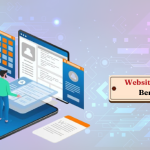In the rapidly evolving world of web design, staying current with the latest trends is crucial for creating engaging, user-friendly, and aesthetically pleasing websites. As we move through 2024, several design trends are shaping the digital landscape. These trends not only enhance the visual appeal of websites but also improve usability and accessibility. Let’s dive into some of the most prominent web design trends of this year, which are essential for any web design company aiming to stay ahead of the curve..
1. Minimalist Design
Minimalist design continues to dominate the web design space in 2024. Characterised by simplicity and functionality, minimalism focuses on using fewer elements to create a clean, uncluttered look. This approach not only enhances the visual appeal but also improves the user experience by reducing distractions and making navigation straightforward.
Key features of minimalist design include:
- Ample White Space: Generous use of white space helps to highlight content and create a balanced layout.
- Simple Colour Palettes: Minimalist designs often use a limited colour palette, typically neutral tones, to maintain a clean look.
- Clean Typography: Simple, sans-serif fonts are preferred for their readability and modern appearance.
- Essential Elements Only: Only necessary elements are included, ensuring that every component has a clear purpose.
2. Dark Mode
Dark mode has become a staple in modern web design, offering an alternative to traditional light interfaces. This trend gained popularity due to its aesthetic appeal and practical benefits, such as reducing eye strain in low-light environments and saving battery life on OLED screens.
Key characteristics of dark mode include:
- Dark Backgrounds: Typically, dark mode uses black or dark gray backgrounds with lighter text.
- High Contrast: Ensuring text and other elements stand out against the dark background is crucial for readability.
- Vibrant Accents: Bright accent colours can be used to highlight important buttons and links, creating a striking visual contrast.
- User Preference: Many websites now offer a toggle switch, allowing users to choose between dark and light modes based on their preference.
3. Responsive Design
With the increasing variety of devices used to access the web, responsive design remains essential. A responsive design ensures that websites look and function well on all screen sizes, from smartphones to desktops.
Key aspects of responsive design include:
- Fluid Grids: Using a grid system that scales based on the screen size ensures that the layout adapts seamlessly.
- Flexible Images: Images and media adjust their size and resolution based on the device, ensuring fast loading times and optimal display.
- Media Queries: CSS media queries are used to apply different styles depending on the device characteristics, such as screen width and orientation.
- Mobile-First Approach: Designing for mobile devices first and then scaling up for larger screens ensures a better user experience across all devices.
4. 3D Elements and Illustrations
3D elements and illustrations are becoming increasingly popular in web design. They add depth and realism to websites, making them more engaging and interactive. Advances in technology have made it easier to incorporate 3D graphics without compromising loading times or performance.
Key features of 3D elements and illustrations include:
- Interactive 3D Models: Allowing users to interact with 3D objects can enhance engagement and provide a unique user experience.
- Detailed Illustrations: High-quality 3D illustrations can make a website stand out and convey complex ideas more effectively.
- Augmented Reality (AR) Integration: Some websites are starting to integrate AR to provide immersive experiences, particularly in e-commerce and product showcases.
5. Micro-Interactions
Micro-interactions are small animations or design elements that provide feedback to users. They play a crucial role in enhancing the user experience by making interactions feel more intuitive and responsive.
Examples of micro-interactions include:
- Hover Effects: Changing the appearance of buttons or links when hovered over.
- Loading Animations: Providing visual feedback while content is loading.
- Interactive Form Fields: Highlighting form fields or showing validation messages in real-time.
- Notification Badges: Indicating new messages or updates with subtle animations.
6. Voice User Interface (VUI)
With the rise of smart speakers and voice assistants, voice user interfaces (VUI) are becoming an important aspect of web design. Incorporating voice search and commands can enhance accessibility and provide a hands-free browsing experience.
Key aspects of VUI include:
- Voice Search Optimization: Ensuring that websites are optimized for voice search queries.
- Voice Commands: Allowing users to navigate the website or perform actions using voice commands.
- Audio Feedback: Providing auditory feedback to confirm actions or notify users.
7. Customizable User Experiences
Personalization is key in 2024, with more websites offering customizable user experiences. This trend involves tailoring content and features to individual users based on their preferences, behavior, and demographics.
Key features of customizable user experiences include:
- User Profiles: Allowing users to create profiles and save their preferences.
- Dynamic Content: Displaying content that adapts to the user’s interests and past interactions.
- AI and Machine Learning: Using AI to predict user needs and personalize the experience in real-time.
- Localization: Adapting content and design based on the user’s geographic location.
8. Bold Typography
Bold typography is making a statement in web design, with designers using large, attention-grabbing fonts to create a strong visual impact. This trend is particularly effective for headlines and calls to action, making it easier to convey important messages.
Key features of bold typography include:
- Oversized Fonts: Using larger-than-usual fonts for headlines and key text elements.
- Contrasting Text: Ensuring that bold text contrasts sharply with the background for readability.
- Unique Fonts: Choosing distinctive fonts that reflect the brand’s personality and stand out visually.
- Minimal Text: Pairing bold typography with minimal text to keep the design clean and focused.
9. Immersive Storytelling
Immersive storytelling is a trend that combines visual design, interactive elements, and compelling narratives to create engaging user experiences. This approach is particularly effective for brands looking to build emotional connections with their audience.
Key features of immersive storytelling include:
- Visual Narratives: Using images, videos, and animations to tell a story.
- Interactive Elements: Incorporating elements like scroll-triggered animations and clickable hotspots to engage users.
- Sequential Content: Presenting content in a logical, story-like sequence that guides users through the experience.
- Emotional Appeal: Crafting stories that resonate emotionally with the audience.
10. Sustainability in Design
With growing awareness of environmental issues, sustainability in design is becoming increasingly important. This trend involves making design choices that reduce the environmental impact of websites.
Key aspects of sustainable design include:
- Efficient Coding: Writing clean, efficient code that reduces server load and energy consumption.
- Optimized Images: Using image formats and compression techniques that reduce file sizes without compromising quality.
- Green Hosting: Choosing web hosting providers that use renewable energy sources.
- Minimal Resource Use: Designing websites that require fewer resources to load and run efficiently.
Conclusion
The web design trends of 2024 reflect a blend of aesthetic appeal, functionality, and user-centric design principles. From the clean lines of minimalist design to the eye-friendly dark mode, and from the adaptability of responsive design to the interactivity of 3D elements and micro-interactions, these trends are shaping the future of web design. As technology continues to advance, staying updated with these trends will be crucial for creating website designs that are not only beautiful but also highly functional and engaging.








